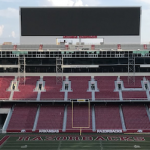By Mark Ferguson
I have to challenge the thoughts of Rex Nelson regarding the tapering of Razorback games from Little Rock because they come from a place of fond memories and personal loss.
It is unfair to be critical of the University of Arkansas for looking at a spreadsheet and seeing that War Memorial Stadium no longer makes financial sense for their program. In the pre-TV and limited-TV era with the trip to Fayetteville taking about twice as long as it does today, it was in the UA’s financial interest to play in Little Rock.
Razorback Stadium had 18,000 seats to Little Rock’s 31,000. Razorback Stadium didn’t exceed 30,000 seats until 1957 and didn’t top 40,000 until 1969. War Memorial had already topped 53,000 seats in 1967. With the seats generally being sold, that capacity difference mattered.
The Razorbacks didn’t play in Little Rock because it had a great atmosphere, but because Little Rock increased the revenues of the UA program.
This is not an Arkansas “loss” it’s Little Rock’s loss because it is Little Rock that has dropped the ball.
The folks at War Memorial have done an admirable job improving War Memorial Stadium, squeezing the most out of dollars they have.
The problem is Little Rock is no longer playing the deck of cards they once held. War Memorial no longer offers larger crowds with larger revenue.
More importantly Little Rock isn’t playing the game the way other cities are playing the neutral-site game. Major games are showing up in places like Dallas and Atlanta because the cities or the stadiums are making offers college football programs cannot refuse. Saint Louis and Kansas City are offering Arkansas State seven figures to move the Red Wolves home game against Mizzou.
Rex Nelson suggests that Arkansas State will leap into the void created by the Hogs. I do not believe that is true.
While Arkansas State University System President Chuck Welch lives in Little Rock, there are many A-State alums, such as myself, who also live in Central Arkansas, and we happily load up for the less than two hour drive (at least when I’m driving) to go back to the campus of our youth to see and reconnect with old friends.
From a business standpoint, playing in Little Rock increases A-State’s overhead by about $100,000. A-State athletic director Terry Mohajir does not strike me as a person who will risk increasing his overheard unless there is a solid certainty of that risk being financially rewarded.
Until Little Rock changes its approach to the business and begins making financial guarantees securing FBS schools to play in War Memorial will be difficult.
While Little Rock does not have the resources of Dallas, Atlanta, Saint Louis or Kansas City, the Rock has to find a way to compete if it wants to be a neutral-site player.
Consider Mobile, Ala. The city places itself on the hook for one million dollars each year to host a bowl game. Whatever the bowl makes in title sponsorships is rebated back to the city. Mobile has been paying about a half million dollars after sponsorships to host a Sun Belt and Mid-American Conference team. The city gains exposure to more than one million television viewers, and they get a few days of full hotels and full restaurants. Having traveled there the last two years, Mobile also gains positive word-of-mouth.
The idea of a bowl in Little Rock had some support, but there was a great deal of scoffing at the idea of hosting a bowl game in Little Rock if it couldn’t bring in “big” name teams. Never mind that 10,000 to 15,000 Arkansans have trekked to Mobile the past two years spending one to three nights in hotels and buying a lot of expensive meals.
New Orleans, Mobile, and Montgomery, Ala., have all been willing to step in and do what many in Little Rock considered pointless or beneath the city.
Rex suggests that UALR might be ready to step forward and start football.
UALR has a larger activity fee for athletics than Arkansas State. Finding the funds to start football and keep it operating will be a challenge. You can be sure Little Rock’s city government will not pledge to buy thousands of tickets each year to prop up the program as the Birmingham city council has done.
Maybe the resources are available, but it is not an easy venture.
South Alabama approved football in December of 2007, played their first season of seven games in 2009, playing prep schools, junior colleges and club teams. In 2010 they played solely four year schools, a mix of NAIA, Division II, and FCS. In 2011 FCS and lower division teams. Then in 2012 they began playing an FBS schedule and became fully FBS this season. They are currently 6-17 since scheduling as an FBS school and they are struggling to sell tickets.
Most likely if UALR adds football, the school will follow the path of metropolitan-based schools using large civic owned stadiums and try to find a way to build their own facility on or near campus as has happened or is being considered with Houston, UAB, South Alabama, SMU, Tulane, and Memphis. The new program at Charlotte opted to start by building their own stadium rather than sharing the local NFL stadium.
Even if UALR starts football, they won’t recapture the magic Rex Nelson describes as shown by the experience of other similar metropolitan colleges.
FBS football in Little Rock isn’t likely to be part of the future unless the community chooses to create a war chest to subsidize football whether it is Razorback, Red Wolf, Trojan or bowl game football.
***
Mark Ferguson, lives in Sherwood and is a student of the business of the game of college football. Follow him on twitter @arkstfan.













